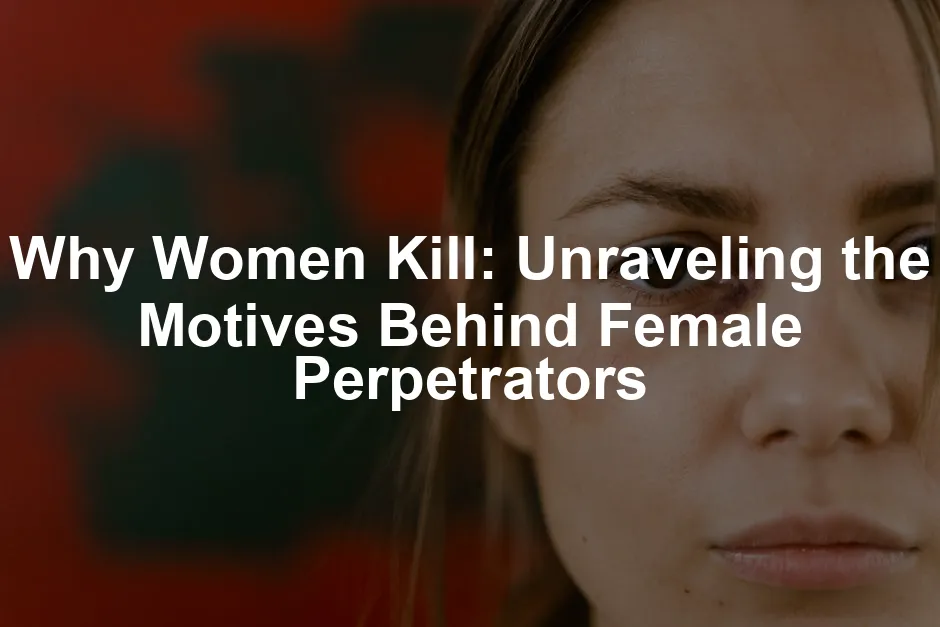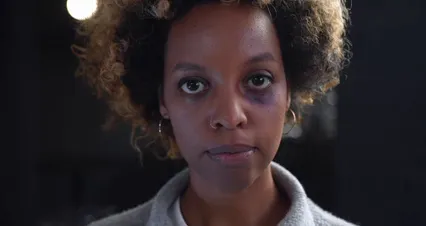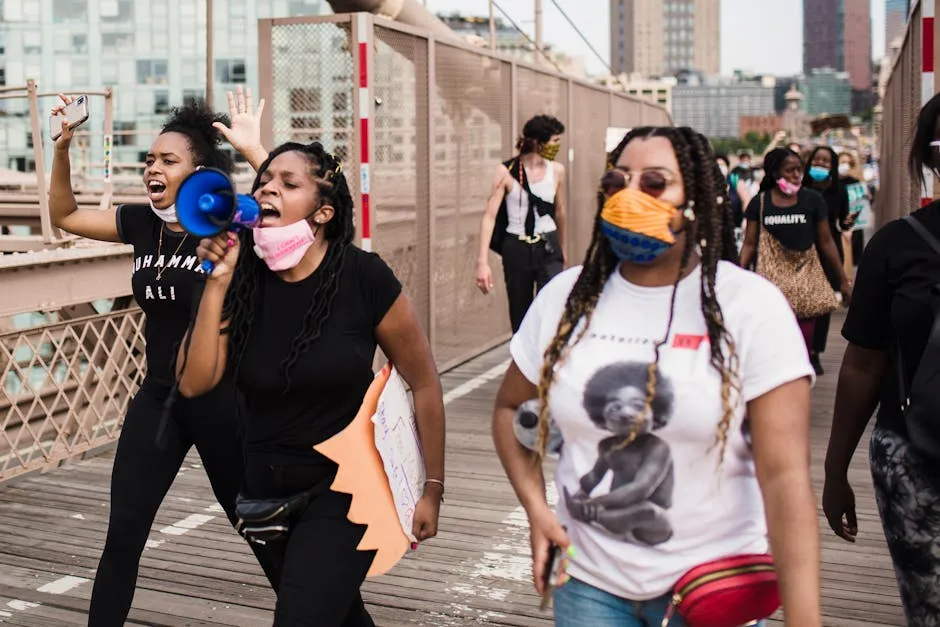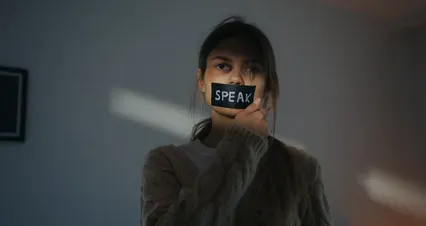
Why Women Kill: Unraveling the Motives Behind Female Perpetrators
Introduction
This article dives into the compelling topic of female violence, particularly focusing on the question: “Why do women kill?” While it may seem counterintuitive to consider women as violent perpetrators, examining the motivations and circumstances that lead to such actions reveals a complex interplay of societal pressures, personal trauma, and psychological factors. From the darkly comedic lens of the TV series “Why Women Kill”, we explore the underlying themes that drive women to commit such acts, challenging stereotypes and societal norms along the way.
In society, women are often viewed through a lens of gentility and nurturing. However, this perception can lead to oversimplified views of female behavior. The characters in “Why Women Kill” exemplify the emotional and situational nuances women face. As we dissect these narratives, we uncover motivations that range from revenge to self-defense, often stemming from deep-rooted issues.
Our exploration isn’t just about sensationalized portrayals of violence. It’s about understanding real-life implications of these actions. By dissecting the complexities behind women’s violent behavior, we aim to shed light on a topic often shrouded in misunderstanding and stigma.
Join us as we dissect the multifaceted reasons behind women’s violent actions. Together, we’ll uncover the layers of trauma, societal expectations, and personal battles that lead some women down a path of violence. In doing so, we hope to foster a deeper understanding and empathy for those affected by these tragic events.

Summary
This article will explore the intricate motivations behind why women commit murder, drawing insights from various studies, psychological analyses, and cultural narratives. We will examine:
- Historical Context: Understanding how societal norms have shaped women’s roles and responses to oppression.
- Personal Factors: The impact of trauma, mental health issues, and relationships on women’s propensity for violence.
- Cultural Representations: How media portrayals, such as in the series “Why Women Kill”, influence public perception of female violence.
- Case Studies: A look at notable historical and contemporary cases to highlight patterns and motivations behind women’s killings.
- Psychological Theories: Exploration of theories that explain why women might resort to lethal actions compared to men.
- Conclusion: Understanding the implications of these findings for society, particularly in terms of justice, mental health, and gender roles.
By the end of this article, readers will gain a nuanced understanding of the complexities surrounding women’s violent behavior, challenging preconceived notions and encouraging deeper discussions about gender and violence. The journey through these insights reveals not only the factors at play but also the societal structures that often contribute to these tragic outcomes. We aim to facilitate conversations that go beyond sensationalism, urging readers to think critically about the reasons behind such extreme actions.

The Historical Context of Female Violence
For centuries, women have been boxed into roles. Society expected them to be nurturing, obedient, and passive. These traditional gender roles have often led to frustration. When confined to the domestic sphere, women sometimes resorted to violence as an expression of their suppressed emotions.
Take, for instance, the case of women in Ancient Rome. Women had limited rights, often subject to the whims of their fathers or husbands. Violence emerged as a tragic byproduct of their entrapment. History shows that women like Lucretia resorted to extreme measures, leading to dramatic societal changes.
In other cultures, similar patterns emerge. In Japan, the concept of “killing in the name of honor” has roots in deeply ingrained societal expectations. Women who acted against family or societal norms faced dire consequences. The frustration from these constraints sometimes manifested in violent actions, as seen in numerous historical accounts.
Fast forward to the modern era, when the rise of feminism began to shift these expectations. The feminist movement championed women’s rights, pushing against traditional boundaries. This change didn’t just empower women; it also altered their responses to oppression. Suddenly, women had voices and choices.
However, with this empowerment came new challenges. Women began to navigate a world where expectations were shifting rapidly. They faced societal backlash for asserting themselves. This tension sometimes resulted in violence, as seen in cases where women felt betrayed or cornered.
Today, we see a complex interplay of societal norms and personal choices. The characters in the series “Why Women Kill” reflect this evolving landscape. They face betrayal, infidelity, and societal judgment, ultimately challenging the stereotypes surrounding female behavior. As they navigate their lives, their responses vary widely, showcasing the nuances of female violence.
Understanding this historical context is crucial. It reveals how deeply-rooted societal expectations can shape behaviors. Women, once confined, have evolved into multifaceted individuals. Their violence often arises from a tapestry of frustration, betrayal, and empowerment.

Personal Factors Influencing Female Killers
Personal experiences play a significant role in shaping violent behavior among women. Childhood trauma often emerges as a powerful predictor of future violence. Many female offenders have histories marked by abuse or neglect.
Research shows that women who experience trauma early in life are more likely to exhibit violent behavior later. The pain from these experiences can lead to a simmering rage, which may eventually explode. This is particularly true in cases where they have been victims of longstanding abuse.
Mental health issues also factor heavily into this equation. Studies indicate that a considerable number of female killers suffer from mental health disorders, such as depression or anxiety. These issues can distort perceptions, leading to irrational decisions and violent outcomes.
It’s essential to recognize the relationship dynamics at play. Toxic relationships often escalate to violence. Jealousy, betrayal, and manipulation can push a woman to her breaking point. Many cases highlight how a partner’s infidelity or emotional abuse can trigger a violent response.
Consider the story of a woman who, upon discovering her partner’s infidelity, feels her world collapse. The betrayal isn’t just emotional; it strips away her sense of self-worth. In a moment of rage, she may lash out violently, believing it’s the only way to reclaim her agency.
As we analyze these factors, it’s clear that personal histories, mental health, and relationships intertwine to create a complex web. This web can lead some women down a path of violence. Understanding these influences is crucial for fostering empathy and crafting appropriate interventions. By addressing these underlying issues, society can help prevent future tragedies and promote healthier relationships.

Media Representations of Women and Violence
Case Study: “Why Women Kill”
The TV series “Why Women Kill” serves as a fascinating lens through which to examine societal attitudes toward women and violence. Spanning several decades, it tells the stories of three women—each with unique backgrounds—navigating infidelity and betrayal. The characters are not mere archetypes but complex individuals shaped by their circumstances.
Take Beth Ann Stanton, for instance. In the 1960s, she embodies the quintessential housewife, struggling to reconcile her role with personal desires. When she discovers her husband’s infidelity, her emotions spiral. The show cleverly illustrates how her seemingly mild-mannered demeanor can mask a tempest of rage. This reflects a broader cultural narrative: women are often expected to remain passive. When they break free from these confines, the results can be explosive.
Simone Grove, a character from the 1980s, offers another perspective. She faces her own challenges when her husband’s secret life is unveiled. In a world where women are increasingly liberated, Simone’s violent outbursts challenge the notion that empowerment equates to calmness. The series highlights that when pushed to the brink, women can react violently, defying traditional gender norms.
Finally, Taylor Harding’s arc in 2019 showcases modern complexities. In an open marriage, jealousy and violence arise, demonstrating that even in progressive relationships, emotional turmoil can lead to drastic actions. The show encapsulates the idea that societal expectations can push women into desperate situations.
The series also intertwines humor and drama, creating a rich narrative tapestry. Each storyline serves as a commentary on the evolving roles of women in society. By portraying the characters’ motivations, “Why Women Kill” encourages audiences to question their preconceptions about female violence.

Impact of Media on Perception
Media representations significantly shape public perception of female killers. Historically, women who commit violent acts are often depicted as monstrous or deranged. Such portrayals can lead to a skewed understanding of the motivations behind their actions. Shows like “Why Women Kill” challenge these stereotypes, presenting female characters as multidimensional individuals rather than mere villains.
Additionally, the humor interspersed in the series allows for a more accessible discussion about serious topics. When audiences laugh, they may also reflect on the absurdity of societal expectations placed on women. This combination can foster empathy, encouraging viewers to engage with the complexities of female violence rather than dismissing it as purely irrational.
Moreover, sensationalized representations in film and television can create fear and misunderstanding. Many people may believe that female killers act without motive, ignoring the emotional and psychological factors at play. By showcasing the backstories and motivations of characters, “Why Women Kill” helps demystify the reasons behind such drastic actions.
In essence, media plays a crucial role in shaping societal attitudes. By portraying female killers in a nuanced light, shows can challenge harmful stereotypes and promote a deeper understanding of the underlying issues that lead women to violence. As viewers engage with these narratives, they may develop a more informed perspective on female violence, moving beyond outdated notions of female passivity.

Notable Case Studies of Female Killers
Historical Cases
Throughout history, infamous female killers have captured public attention. Take Lizzie Borden, for example. In 1892, she was accused of murdering her parents with an axe. While the case remains shrouded in mystery, motivations are often speculated to include inheritance and familial strife. Borden’s trial captivated the nation, highlighting societal fascination with women who defy expectations through violent acts. To dive deeper into this case, you might enjoy reading The Lizzie Borden Chronicles.
Another notorious figure is Aileen Wuornos, a serial killer active in the late 1980s and early 1990s. Her tumultuous life, marked by abuse and abandonment, paints a tragic picture of how personal trauma can lead to violence. Wuornos claimed her victims were abusive clients, raising questions about self-defense versus premeditated acts. Her case underscores the complexities of female violence, challenging simplistic narratives of evil. For a deeper understanding, consider reading Aileen Wuornos: The Life and Death of a Serial Killer.
Contemporary Examples
In recent years, cases of female killers have continued to emerge, reflecting current societal trends. One example is Jodi Arias, who was convicted in 2013 for the murder of her ex-boyfriend, Travis Alexander. Her case drew massive media coverage, with debates surrounding the motivations behind her actions. Was it a crime of passion or calculated revenge? The sensationalism surrounding Arias highlighted how media can influence public perceptions of female criminals. For more insights into this case, consider checking out Women Who Kill: A True Crime Anthology.
Similarly, the story of Casey Anthony captivated audiences when she was accused of murdering her daughter, Caylee. The trial became a media circus, showcasing the public’s obsession with maternal figures who turn violent. Anthony’s case revealed the societal conflict between the expectations of motherhood and the potential for violence, forcing viewers to grapple with their biases.
These historical and contemporary examples illustrate that women’s motivations for violence are often complex and multifaceted. By examining these cases, we gain insight into the psychological and societal factors at play. Understanding these narratives helps create a more nuanced view of female killers, encouraging empathy rather than fear.

Psychological Theories Behind Female Violence
Gender Differences in Violence
When it comes to violence, men and women often take different paths. Traditional psychological theories suggest that societal conditioning heavily influences these paths. For instance, men are generally encouraged to express aggression and dominance, while women are often taught to embody nurturing qualities. This difference creates a unique landscape for understanding female violence.
One theory posits that women may resort to violence as a reaction to perceived threats or betrayals. Unlike men, who might act out physically, women often internalize their feelings until they explode. This internalization can lead to situations where violence emerges as a last resort. When pushed to their limits, women might commit acts of violence that reflect their emotional turmoil rather than a straightforward desire to harm.
Moreover, women tend to use different methods than men when it comes to violence. Research indicates that female perpetrators are more likely to use poison or other indirect means compared to the more direct methods typically associated with male violence. This distinction aligns with societal norms that encourage women to be more subtle and strategic in their actions.
Another aspect to consider is the role of relational aggression. Women are often socialized to use manipulation or emotional tactics rather than overt physical aggression. This can manifest in harmful behaviors that result in violence. For instance, a woman may feel betrayed and, instead of confronting her partner, she might plot revenge. These patterns highlight the complexities behind female violence, emphasizing that motivations can be tied to emotional and psychological factors unique to women.

Influence of Socialization
Socialization plays a pivotal role in shaping behaviors. From an early age, girls are often taught to cherish relationships and prioritize harmony. As a result, when conflicts arise, they may struggle to express anger directly. This internal conflict can lead to feelings of frustration and helplessness, which, when bottled up, can ultimately explode into violence.
Gender norms dictate how women should behave, often labeling assertiveness as “bitchy” or “hysterical.” These negative labels discourage women from expressing their emotions healthily. Thus, when faced with betrayal or emotional pain, some women may resort to violence as a misguided means of reclaiming control. This behavior reflects societal pressures that create a paradox: women are expected to be passive, yet they are also held accountable for their reactions when they assert themselves.
Additionally, the media often perpetuates stereotypes surrounding female violence. Movies and television shows frequently depict women as emotional, reactive beings, reinforcing the idea that when women do resort to violence, it stems from their emotional instability. This portrayal can lead to societal stigmas that overlook the deeper issues at play, such as trauma, mental health, and societal pressures.
As we continue to analyze female violence, it becomes clear that socialization profoundly impacts behavior. Understanding the influence of gender norms and societal expectations allows for a more nuanced perspective on why women may kill. By considering these psychological theories, we can foster conversations that promote awareness and empathy rather than judgment.

Conclusion
In exploring the reasons why women commit violent acts, we uncover a multifaceted tapestry woven from psychological, social, and cultural threads. The motivations behind female violence are rarely straightforward. They often stem from a complex interplay of personal trauma, societal expectations, and emotional responses.
Understanding these motivations is crucial, especially in light of ongoing societal changes. As gender roles evolve, so too do the pressures and expectations placed on women. Mental health remains a significant factor in this conversation. Addressing mental health issues and societal pressures can lead to healthier coping mechanisms, reducing the chances of violent outbursts.
Moreover, the justice system’s treatment of female offenders often reflects societal biases. Women may be judged more harshly for their actions, as society grapples with the contradiction of women as nurturers versus perpetrators. By fostering a deeper understanding of the challenges women face, we can advocate for more compassionate approaches within the legal system.
Encouraging discussions around this often stigmatized topic is essential for promoting empathy. As readers, we must question our preconceptions and strive for a more informed view of female violence. By doing so, we not only help to dismantle harmful stereotypes but also contribute to a more nuanced understanding of the complexities surrounding women’s actions. Let’s continue this vital conversation, embracing the intricacies of human behavior while challenging societal norms.

FAQs
What psychological factors contribute to women’s violent behavior?
Women’s violent behavior often roots deeply in psychological trauma. Many female offenders experience significant childhood trauma, which can manifest as aggression later in life. Mental health issues, such as depression and anxiety, frequently accompany these experiences. Socialization also plays a role. Women are often taught to suppress anger, leading to internalized frustration. This internal conflict can erupt violently when pushed to the limit. When societal pressures combine with personal trauma, the consequences can be dire.
How does media representation influence public perception of female killers?
Media portrayal shapes public perception significantly. Often, female killers are depicted as emotional or unstable. Such stereotypes can lead society to view women who commit violence as inherently monstrous. However, shows like ‘Why Women Kill’ challenge these narratives. They present women as multifaceted individuals facing complex situations. By humanizing these characters, media can encourage audiences to understand rather than judge female violence. The combination of dark humor and serious themes fosters a more nuanced discussion around female aggression.
Are women who kill treated differently in the justice system compared to men?
Yes, women often encounter different treatment in the justice system. Gender biases can influence legal outcomes, with women sometimes receiving more lenient sentences. Society tends to view female killers through a lens of surprise, given traditional gender norms. This can lead to a perception that women are less dangerous, affecting jury decisions and sentencing. On the flip side, women can also face harsher scrutiny for breaking societal expectations. Understanding these biases is crucial for addressing disparities in the legal system.
What can be done to address the issues surrounding female violence?
Tackling female violence requires a multifaceted approach. Mental health support is essential to help individuals process trauma and develop healthy coping strategies. Awareness campaigns can educate the public about the factors leading to female violence, reducing stigma. Educational programs aimed at young people can promote emotional intelligence and conflict resolution skills. By addressing root causes and fostering understanding, society can work towards preventing violence and supporting those affected by it.
Understanding emotional responses is crucial for mental health, especially when analyzing the motivations behind female violence. why understanding emotional responses is crucial for mental health
Please let us know what you think about our content by leaving a comment down below!
Thank you for reading till here 🙂
All images from Pexels




